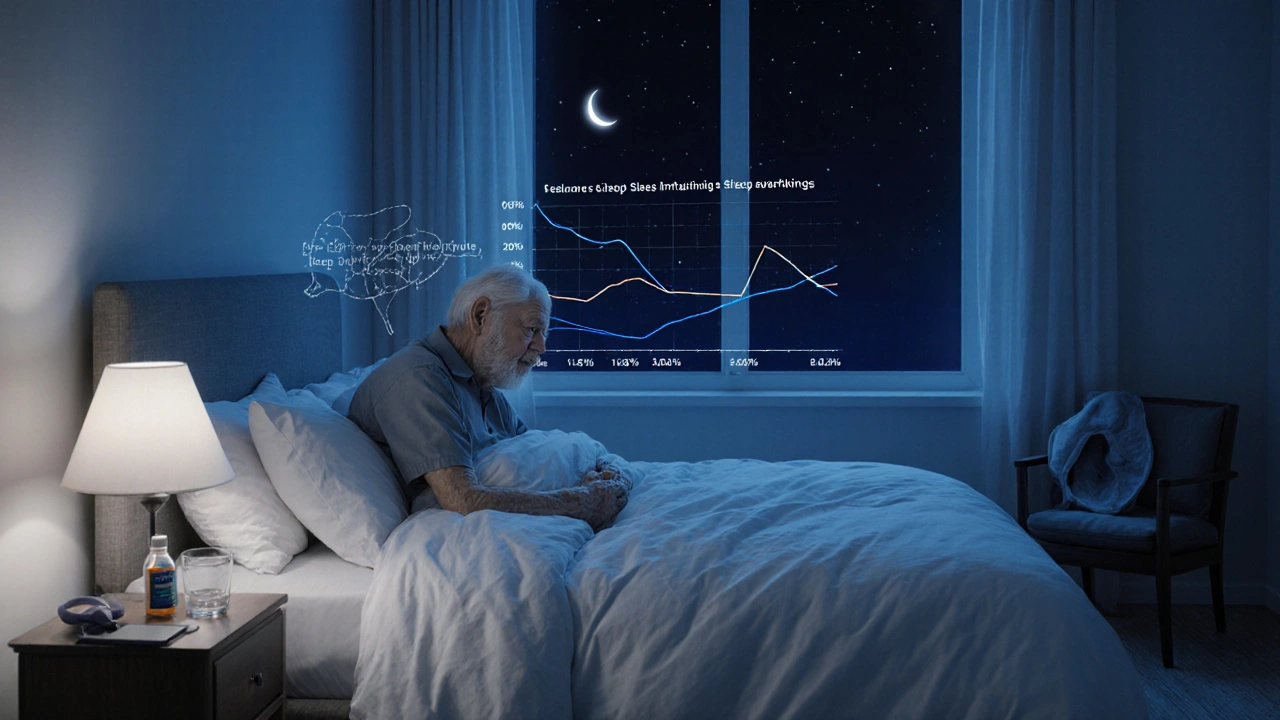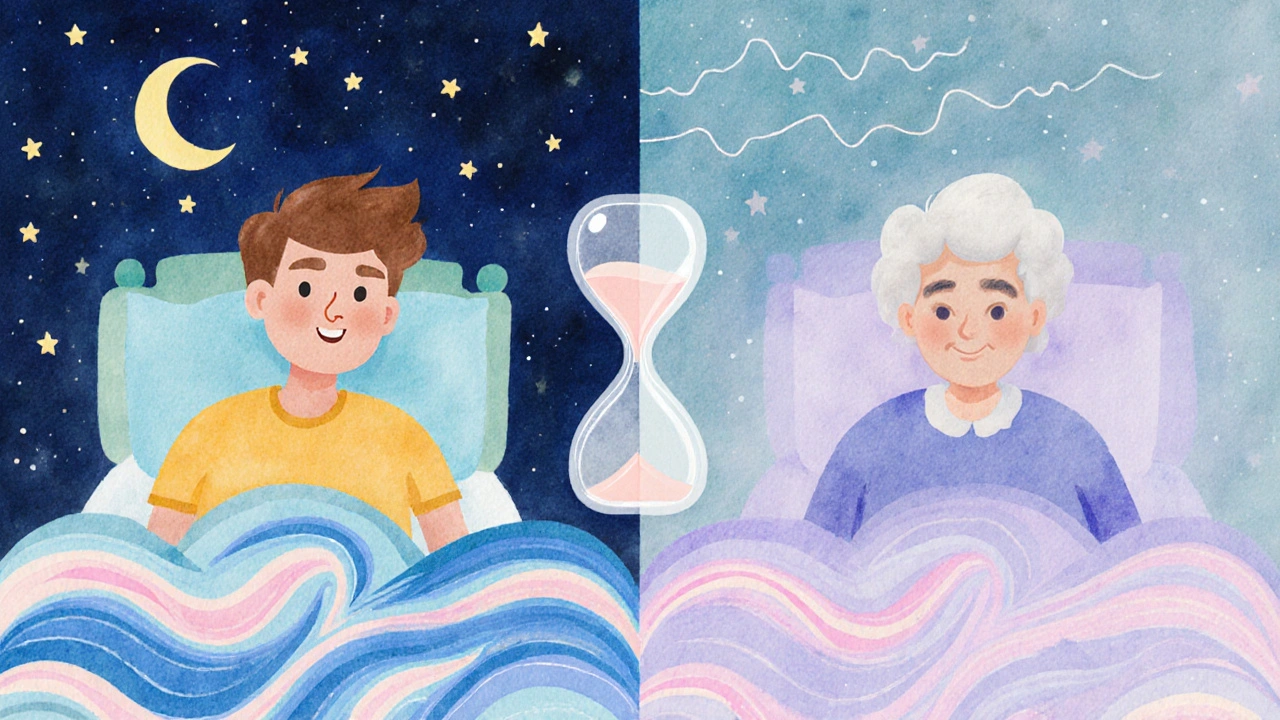
Sleep Pattern Analyzer
Track your sleep habits and see how they align with age-related sleep changes. Enter your information below to get personalized insights.
Ever wondered why the pillow seems less inviting as you get older? Insomnia is a condition where falling asleep, staying asleep, or getting restorative sleep becomes a nightly struggle. It isn’t just a nuisance; it can reshape mood, memory, and even heart health. As the years accumulate, the body’s Aging the gradual biological process that affects every organ system, including the brain’s sleep centers brings a fresh set of sleep challenges. This guide unpacks how your sleep needs shift, why insomnia becomes more common after 60, and what practical steps can keep your nights restful.
Key Takeaways
- Total sleep time drops by about 20‑30 minutes after age 60.
- Deep (slow‑wave) sleep declines, while light sleep dominates.
- Melatonin production wanes, nudging the circadian rhythm earlier.
- Common older‑adult disorders include sleep apnea, restless legs, and periodic limb movements.
- Simple changes in Sleep Hygiene behaviors that promote consistent, high‑quality sleep, such as a cool dark room and regular bedtime can cut insomnia episodes in half.
How Sleep Architecture Shifts With Age
The brain’s nightly routine-known as Sleep Architecture the pattern of sleep stages (N1, N2, N3, REM) that repeat in cycles throughout the night-is a moving target. In youth, a typical night consists of 4-5 cycles, each lasting about 90 minutes, with a healthy mix of light (N1, N2), deep (N3, also called slow‑wave sleep), and REM sleep. By the time you’re in your 70s, three major changes surface:
- Less deep sleep. N3 can shrink from 20‑25% of total sleep time to under 10%.
- More frequent awakenings. The brain becomes less adept at staying in a single cycle, leading to fragmented sleep.
- Earlier bedtime preference. The Circadian Rhythm the internal 24‑hour clock that regulates sleep‑wake timing subtly shifts earlier, making “night owl” habits harder to keep.
These physiological tweaks explain why many seniors find themselves in bed earlier but still feel restless at night.
Hormonal Changes: The Melatonin Factor
Melatonin, the hormone that signals darkness to the brain, peaks around 2-4am in younger adults. Production starts to drop after the mid‑50s, and the peak advances to an earlier hour. The effect? A narrower window for deep, restorative sleep and a tendency to wake up at sunrise, even if you’d prefer to stay down.
Research from the National Sleep Foundation in 2023 showed that nightly melatonin levels in adults over 65 were on average 30% lower than in those aged 30‑40. The result is a weaker sleep‑inducing signal that can tip the balance toward insomnia.
Common Sleep Disorders That Crop Up Later In Life
While the natural evolution of sleep architecture explains many nighttime frustrations, specific disorders often add fuel to the fire. Recognizing them early can prevent chronic insomnia.
- Sleep Apnea a condition where the airway collapses intermittently during sleep, causing brief pauses in breathing: Prevalence jumps to 20‑30% in adults over 65. Loud snoring, choking sounds, and morning headaches are red flags.
- Restless Legs Syndrome (RLS) an irresistible urge to move the legs, usually worse at night: Affects roughly 10% of seniors and often leads to frequent leg‑twitching that interrupts sleep.
- Periodic Limb Movement Disorder: involuntary jerks of the limbs every 20‑40 seconds, often unnoticed by the sleeper but evident on a partner’s report.
- Medication‑induced insomnia: many prescriptions for blood pressure, depression, or allergies have stimulating side‑effects that surface at bedtime.

Practical Tips to Tame Insomnia as You Age
Small, consistent habits can dramatically improve sleep quality. Below is a checklist you can start today.
- Anchor your bedtime. Choose a “lights‑out” time and stick to it-even on weekends. Consistency reinforces the circadian rhythm.
- Dim the lights an hour before bed. Blue‑light from phones suppresses melatonin. Switch to amber bulbs or use a blue‑light filter.
- Keep the bedroom cool. Aim for 16‑18°C (60‑65°F). Cooler temps promote deeper N3 sleep.
- Limit liquids after dinner. Reduces nighttime bathroom trips that fragment sleep.
- Gentle movement in the afternoon. A 20‑minute walk boosts sleep drive without over‑stimulating the nervous system.
- Mindful breathing or progressive muscle relaxation for 5‑10 minutes can lower cortisol, the stress hormone that hijacks sleep.
- Consider low‑dose melatonin. 0.3‑0.5mg taken 30 minutes before bed can help reset the clock, but consult a doctor first.
- Screen for sleep apnea. If you snore loudly or feel exhausted despite adequate time in bed, a sleep study may be warranted.
When to Call a Healthcare Professional
Occasional sleepless nights are normal, but persistent insomnia-defined as trouble falling asleep or staying asleep at least three nights per week for a month-deserves attention. Seek help if you notice any of these signs:
- Daytime fatigue that interferes with daily activities.
- Memory lapses, confusion, or mood swings.
- Worsening of existing health conditions (e.g., high blood pressure, diabetes).
- Frequent nocturnal awakenings with gasping or choking sounds.
- Dependence on over‑the‑counter sleep aids.
Primary care physicians can evaluate underlying medical causes, adjust medications, or refer you to a sleep specialist for polysomnography.
Comparison of Sleep Metrics by Age Group
| Metric | 20‑30years | 65years+ |
|---|---|---|
| Total Sleep Time (hrs) | 7.5‑8.0 | 6.5‑7.0 |
| Sleep Efficiency(%) | 90‑95 | 80‑85 |
| Deep Sleep (N3)% | 20‑25 | 8‑12 |
| REM Sleep% | 20‑25 | 15‑20 |
| Awakenings per Night | 0‑2 | 3‑5 |
Next Steps for a Restful Future
Start with a self‑audit: Track your bedtime, wake time, and any night‑time disturbances for a week. Use that data to pinpoint which tip or medical concern deserves priority. Remember, sleep is a two‑way street-your daytime habits shape nighttime quality, and quality sleep fuels better health during the day.
Frequently Asked Questions
Why do I feel sleepy earlier in the evening as I get older?
The circadian rhythm naturally shifts earlier with age, a pattern called “phase advance.” Combined with lower melatonin output, the body signals sleep readiness sooner.
Is napping harmful for seniors?
Short naps (20‑30minutes) can boost alertness without disrupting nighttime sleep. Longer naps or late‑day naps may fragment sleep, especially if insomnia is already present.
Can over‑the‑counter sleep aids be used safely?
Occasional use is generally safe, but many contain antihistamines that cause next‑day grogginess and can interact with blood pressure meds. Discuss regular use with a doctor.
How does exercise affect sleep in older adults?
Moderate aerobic activity improves sleep efficiency and increases deep sleep. Timing matters-exercise at least three hours before bedtime avoids a cortisol spike that can delay sleep onset.
What role does diet play in managing insomnia?
Heavy meals, caffeine, and alcohol close to bedtime can disrupt sleep cycles. A light snack with tryptophan (e.g., yogurt, banana) can promote melatonin synthesis and aid sleep.




jenni williams
September 30, 2025 AT 21:06i totally get how frustrating those middle‑of‑the‑night wake‑ups can be 😊
Kevin Galligan
October 1, 2025 AT 15:09well, looks like the universe decided to gift us another round of existential dread at 2 am – thanks, body. maybe try turning the lights off and pretending it’s a spa? 😂
Dileep Jha
October 2, 2025 AT 09:13While the circadian phase advance is empirically validated, the attenuated melatonin surge post‑senescence can be modeled as a damped sinusoidal oscillator, thereby compounding homeostatic sleep pressure dysregulation.
Michael Dennis
October 3, 2025 AT 03:16To the untrained eye the article appears comprehensive; however, it neglects to address the neurochemical cascade involving hypocretin deficiency, which is pivotal in age‑related insomnia pathology.
Blair Robertshaw
October 3, 2025 AT 21:19lol this so obvious lol seniors cant sleep cause they cant chill
Alec Maley
October 4, 2025 AT 15:23yeah, that’s a solid point – the hypocretin angle is often missed. adding a note about orexin modulation could really round out the piece.
Navjot Ghotra
October 5, 2025 AT 09:26i think the article is fine but could use more data
Claus Rossler
October 6, 2025 AT 03:29While your observation ostensibly captures a kernel of truth, it betrays a reductive reductionism that disregards the phenotypic heterogeneity inherent in geriatric sleep architecture. One must eschew such simplistic generalizations lest we perpetuate epistemic complacency.
chris mattox
October 6, 2025 AT 21:33Hey folks, let’s remember that sleep isn’t a one‑size‑fits‑all tapestry; each thread-whether it’s a restless leg or a noisy neighborhood-adds to the vivid mosaic of our nightly rest. Embrace the diversity, and seek strategies that honor your unique rhythm.
Jackson Whicker
October 7, 2025 AT 15:36Ah, the grand orchestra of slumber! If we fail to conduct this symphony with disciplined grace, we are condemned to a cacophony of insomnia, a tragedy worthy of Shakespeare’s quill.
Audrin De Waal
October 8, 2025 AT 09:39Honestly, all this western fluff about “sleep hygiene” is just another way to tell us how to live. In our country we respect natural cycles and don’t need fancy gadgets to tell us when to hit the hay.
parag mandle
October 9, 2025 AT 03:43Sleep hygiene is not merely a checklist, it's an evolving relationship with your own physiology.
First, prioritize a fixed sleep window; your body thrives on predictable cues.
Second, the bedroom environment should be a sanctuary: cool temperatures, darkness, and minimal noise.
Third, limit fluid intake after dinner to avoid nocturnal bathroom trips that fragment sleep.
Fourth, incorporate light aerobic activity in the afternoon, which has been shown to increase deep sleep stages.
Fifth, screen exposure should cease at least an hour before bedtime, as blue light suppresses melatonin.
Sixth, a modest dose of melatonin (0.3–0.5 mg) can realign circadian timing for many older adults, but always discuss with a physician.
Seventh, evaluate your medication list; several antihypertensives and antidepressants can inadvertently stimulate wakefulness.
Eighth, if snoring or gasping is present, consider a sleep study to rule out obstructive sleep apnea.
Ninth, practice relaxation techniques such as progressive muscle relaxation or guided breathing for five to ten minutes.
Tenth, avoid heavy meals, caffeine, and alcohol within three hours of sleep, as they disrupt the sleep architecture.
Eleventh, keep a sleep diary for at least a week to identify patterns and trigger points.
Twelfth, if you notice persistent insomnia lasting more than three nights per week, seek professional help.
Thirteenth, cognitive behavioral therapy for insomnia (CBT‑I) remains the gold standard, outperforming many pharmacologic options.
Fourteenth, remember that daytime naps should be brief (20‑30 minutes) and early, lest they encroach on nighttime sleep.
Finally, view these strategies as a holistic program; consistency yields the most profound improvements.
Shivali Dixit Saxena
October 9, 2025 AT 21:46Remember, eat light, stay cool, dim lights-sleep will thank you, seriously, you’ll feel better, trust the process!
Sayam Masood
October 10, 2025 AT 15:49While the prescriptive nature of the guidelines is commendable, one must also contemplate the existential dimension of nocturnal wakefulness. The night, after all, is a canvas upon which the psyche paints its unresolved narratives.
Jason Montgomery
October 11, 2025 AT 09:53Great tips, everybody! Keep experimenting and find what works best for you.
Wade Developer
October 12, 2025 AT 03:56Indeed, consistent self‑monitoring combined with evidence‑based interventions represents the most rigorous approach to ameliorating age‑related insomnia.